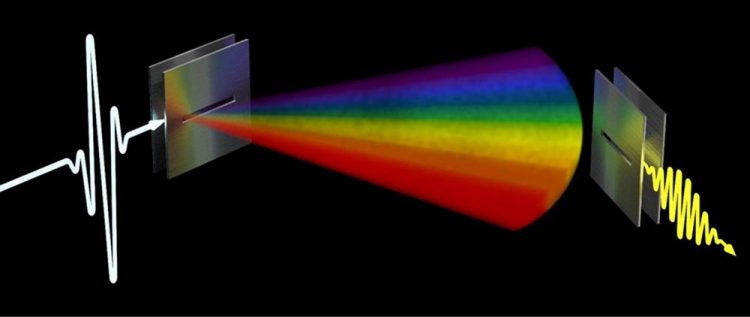Researchers solve 'link discovery' problem for terahertz data networks

Radiation of varying frequencies emanate from a leaky waveguide at different angles. This rainbow of frequencies is the basis for a link discovery system for future terahertz data networks. Credit: Mittleman Lab / Knightly Lab
Because of their high frequency, terahertz waves can carry hundreds of times more data than the microwaves used to carry our data today. But that high frequency also means that terahertz waves propagate differently than microwaves. Whereas microwaves emanate from a source in an omni-directional broadcast, terahertz waves propagate in narrow beams.
“When you're talking about a network that's sending out beams, it raises a whole myriad of questions about how you actually build that network,” said Daniel Mittleman, a professor in Brown's School of Engineering. “One of those questions is how does an access point, which you can think of as a router, find out where client devices are in order to aim a beam at them. That's what we're thinking about here.”
In a paper published in Nature Communications, researchers from Brown and Rice University showed that a device known as a leaky waveguide can be used for link discovery at terahertz frequencies. The approach enables link discovery to be done passively, and in one shot.
The concept of a leaky waveguide is simple. It's just two metal plates with a space between them where radiation can propagate. One of the plates has a narrow slit cut into it, which allows a little bit of the radiation to leak out. This new research shows the device can be used for link discovery and tracking by exploiting one of its underlying properties: that different frequencies leak out of the slit at different angles.
“We input a wide range of terahertz frequencies into this waveguide in a single pulse, and each one leaks out simultaneously at a different angle,” said Yasaman Ghasempour, a graduate student at Rice and co-author on the study. “You can think of it like a rainbow leaking out, with each color represents a unique spectral signature corresponding to an angle.”
Now imagine a leaky waveguide placed on an access point. Depending upon where a client device is relative to the access point, it's going to see a different color coming out of the waveguide. The client just sends a signal back to the access point that says, “I saw yellow,” and now the access point knows exactly where the client is, and can continue tracking it.
“It is not just about discovering the link once,” Yasaman said. “In fact, the direction of transmission needs to be continually adjusted as the client moves. Our technique allows for ultra-fast adaptation which is the key to achieving seamless connectivity.”
The setup also uses a leaky waveguide on the client side. On that side, the range of frequencies received through the slit in the waveguide can be used to determine the position of the router relative to the local rotation of the device — like when someone swivels their chair while using a laptop.
Mittleman says that finding a novel way to make link discovery work in the terahertz realm is important because existing protocols for link discovery in microwaves simply won't work for terahertz signals. Even the protocols that have been developed for burgeoning 5G networks, which are much more directional than standard microwaves, aren't feasible for terahertz. That's because as narrow as 5G beams are, they're still around 10 times wider than the beams in a terahertz network.
“I think some people have assumed that since 5G is somewhat directional, this problem had been solved, but the 5G solution simply isn't scalable,” Mittleman said. “A whole new idea is needed. This is one of those fundamental protocol pieces that you need to start building terahertz networks.”
###
Other co-authors on the paper were Rabi Shrestha and Aaron Charous from Brown University, and Edward Knightly from Rice University. The work was supported by Cisco, Intel and by the National Science Foundation.
Media Contact
More Information:
http://dx.doi.org/10.1038/s41467-020-15761-4All latest news from the category: Information Technology
Here you can find a summary of innovations in the fields of information and data processing and up-to-date developments on IT equipment and hardware.
This area covers topics such as IT services, IT architectures, IT management and telecommunications.
Newest articles

Sea slugs inspire highly stretchable biomedical sensor
USC Viterbi School of Engineering researcher Hangbo Zhao presents findings on highly stretchable and customizable microneedles for application in fields including neuroscience, tissue engineering, and wearable bioelectronics. The revolution in…

Twisting and binding matter waves with photons in a cavity
Precisely measuring the energy states of individual atoms has been a historical challenge for physicists due to atomic recoil. When an atom interacts with a photon, the atom “recoils” in…

Nanotubes, nanoparticles, and antibodies detect tiny amounts of fentanyl
New sensor is six orders of magnitude more sensitive than the next best thing. A research team at Pitt led by Alexander Star, a chemistry professor in the Kenneth P. Dietrich…





















